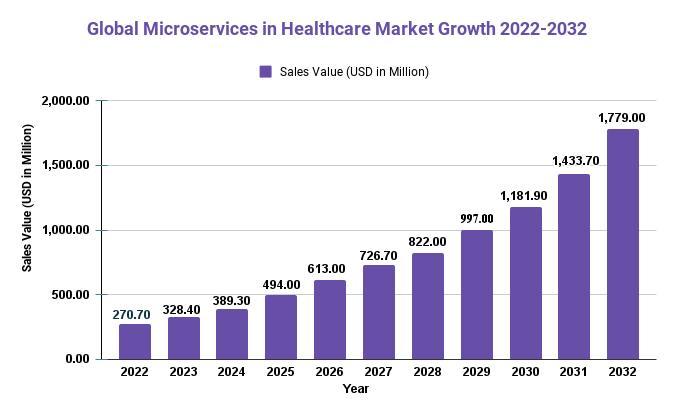Microservices in Healthcare Market to Reach USD 1,779.0 Million by 2032

Page Contents
Market Overview
In 2022, the microservices in healthcare market were estimated to be worth USD 270.7 million and reach their peak value of USD 1779.0 million by 2032 at a compound annual growth rate (CAGR) of 21.3% from 2022-2032.
Microservices in healthcare refer to the utilization of microservices architecture for applications and services within this space. Microservices are small, independent components that can be combined to form larger applications. This architecture offers more flexibility and scalability than traditional monolithic designs, which has driven growth within this market due to growing demands for scalable, agile healthcare solutions, rising cloud adoption rates, and pressure on healthcare costs.
The healthcare providers segment is expected to hold the largest market share during the forecast period, as organizations are increasingly adopting microservices architecture to improve patient engagement, interoperability, and data management capabilities. The cloud-based deployment model is projected to grow at the highest compound annual growth rate (CAGR) during this time due to its numerous advantages such as easy accessibility, scalability, and cost efficiency.
North America is expected to hold the largest market share during the forecast period, due to a large number of healthcare IT companies, rising adoption of advanced technologies, and rising government initiatives promoting healthcare IT solutions. On the other hand, the Asia Pacific region is projected to experience the highest compound annual growth rate due to an increased focus on digitizing healthcare systems, expanding healthcare infrastructure, and increasing investments by key market players within this region.
Drivers, trends, and challenges have an impact on market dynamics, which can impact businesses. Request for PDF sample report

Key Takeaways
- The market is primarily driven by an increasing need for healthcare services, an expanding need for healthcare IT solutions, and efficient healthcare management.
- North America is expected to lead the healthcare IT market, due to its abundance of healthcare IT companies and adoption of cutting-edge technologies.
- The Asia Pacific region is anticipated to experience significant growth due to the rising demand for healthcare services and increased adoption of IT solutions.
Regional Overview
- The global microservices in the healthcare market are divided into North America, Europe, Asia Pacific, Latin America, and the Middle East and Africa.
- North America is anticipated to dominate the healthcare IT market owing to a large number of healthcare IT companies and the widespread adoption of advanced technologies. The US is anticipated to hold the largest share of this regional market.
- Europe is expected to be the second-largest market, thanks to its well-established healthcare infrastructure and adoption of advanced technologies.
- The Asia Pacific region is expected to experience significant growth due to the rising demand for healthcare services and increased adoption of IT solutions. Countries such as China and India are anticipated to spearhead this region's market expansion.
Drivers
- The increasing demand for healthcare services
- The growing need for IT solutions
- The necessity of efficient healthcare management
- Cloud-based solutions
- Mobile Health (mHealth) adoption
- Real-time monitoring and analysis – these are some of the major drivers.
Restraints
- Security concerns related to healthcare data
- Absence of standardization and interoperability
- High implementation costs
- Lack of Skilled Professionals
Overall, the microservices in the healthcare market are forecast to experience significant growth during the forecast period due to increasing demand for healthcare services and the adoption of advanced technologies. Nonetheless, there are some challenges that need to be addressed such as security concerns, lack of standardization, and high implementation costs.
Opportunities
- Scalability and Flexibility: Microservices architecture allows healthcare organizations to scale and adapt according to changing business requirements with ease.
- Cost Efficiency: Microservices architecture helps healthcare organizations save costs by only deploying necessary services and resources.
- Faster deployment: Microservices allow healthcare organizations to quickly launch new services without disrupting existing ones.
- Improved patient outcomes: Microservices architecture allows the development of personalized and real-time healthcare solutions that enhance patient outcomes.
- Improved Interoperability: Microservices architecture can assist healthcare organizations in integrating different systems and data sources, thus increasing interoperability.
Challenges
- Microservices architecture can be complex to design, deploy and manage.
- Integration: Migrating microservices requires integration with other services and systems – an endeavor that presents unique difficulties.
- Security: Microservices architecture can be vulnerable to security risks due to their distributed nature.
- Testing Microservices: Testing microservices presents a unique challenge, as each service must be tested individually as well as in combination with other services.
- Skillset: Microservices architecture necessitates specific abilities in development, testing, deployment, and management.
Recent Developments
- Cloud-native microservices: Healthcare organizations are shifting towards cloud-native microservices for increased scalability, flexibility, and cost efficiency.
- AI-Powered Microservices: Healthcare organizations are leveraging AI to create intelligent healthcare solutions that enhance patient outcomes.
- Blockchain-enabled microservices: Healthcare organizations are exploring blockchain-enabled microservices to improve data security and interoperability.
- Containerization of microservices: Containerizing microservices has become increasingly popular due to its ease of deployment and management.
- Low-code microservices: Healthcare organizations are turning to low-code microservices as a way to reduce development time and costs.
Key Market Segments
Type
- On-premise
- Cloud-based
Application
- Healthcare Payers
- Healthcare Providers
- Clinical Laboratories
- Life Science Organizations
Key Market Players
- IBM
- Oracle
- Amazon Web Services
- Microsoft
- com
- CA Technologies
- Infosys (India)
- NGINX
- Syntel
- Pivotal Software
Report Scope
| Report Attribute | Details |
| The market size value in 2022 | USD 270.7 Mn |
| Revenue forecast by 2032 | USD 1,779.0 Mn |
| Growth Rate | CAGR Of 21.3% |
| Regions Covered | North America, Europe, Asia Pacific, Latin America, and Middle East & Africa, and Rest of the World |
| Historical Years | 2017-2022 |
| Base Year | 2022 |
| Estimated Year | 2023 |
| Short-Term Projection Year | 2028 |
| Long-Term Projected Year | 2032 |
Frequently Asked Questions
Q: What is microservices architecture in healthcare?
Microservices architecture is a software development approach where an extensive application is divided into smaller, independent services that communicate with each other via APIs.
Q: What are the advantages of microservices architecture in healthcare?
A: Microservices architecture offers several advantages, including scalability, flexibility, cost-efficiency, faster deployment timeframes, improved patient outcomes, and enhanced interoperability.
Q: What are the challenges associated with microservices architecture in healthcare?
A: The primary challenges in this space include complexity, integration, security, testing, and specialized skillsets.
Q: What are some recent advancements in microservices architecture within healthcare?
A: Recent innovations include cloud-native microservices, AI-powered microservices, blockchain-enabled microservices, containerization, and low-code microservices.
Q: How can microservices architecture enhance patient outcomes in healthcare?
A: Microservices architecture allows healthcare organizations to create personalized and real-time healthcare solutions that improve patient outcomes. It also facilitates integration between different systems and data sources, leading to improved interoperability.
The team behind market.us, marketresearch.biz, market.biz and more. Our purpose is to keep our customers ahead of the game with regard to the markets. They may fluctuate up or down, but we will help you to stay ahead of the curve in these market fluctuations. Our consistent growth and ability to deliver in-depth analyses and market insight has engaged genuine market players. They have faith in us to offer the data and information they require to make balanced and decisive marketing decisions.